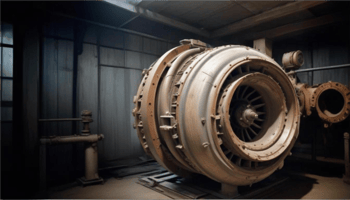A few years ago, a refinery encountered significant issues with control valves that had been stored...
From Storage to Site: The Importance of Detecting Shocks
In industries such as Oil&Gas and Aerospace, the transportation and storage of high value components such as valves and turbines requires special attention to prevent damage and ensure product integrity. In this article, we will explore the importance of shock monitoring and provide real-life examples of damage that has occurred and the resulting economic loss
The Technology Behind Shock Detection
The HALOG device, equipped with advanced shock detection sensors, provides a robust solution for monitoring and protecting these critical components. It is equipped with accelerometers capable of detecting shocks and vibrations. These sensors record every impact event, documenting the magnitude and direction of the shocks experienced by the component. This real-time monitoring capability allows for the identification of when a component has been subjected to mechanical stress
Main Issues Arising from Shock Damage
When a shock occurs during storage or transportation, damaging an OEM's product such as a valve, an electric component, or a turbine, several critical issues can arise:
Structural Damage- Cracks and Deformations: Shock impacts can cause cracks or deformations in the component's structure, compromising its integrity and functionality.
- Material Fatigue: Repeated shocks can lead to material fatigue, reducing the lifespan of the component and increasing the likelihood of future failures
Operational Failures
- Immediate Malfunction: Damaged components may fail to operate correctly upon installation, leading to immediate operational issues.
- Performance Degradation: Even if a component initially appears to function, hidden damage can lead to degraded performance over time, reducing efficiency and reliability.
- Catastrophic Failures: In critical systems, such as power plants or chemical processing facilities, damaged components can lead to catastrophic failures, posing significant safety risks to personnel and infrastructure.
- Hazardous Leaks: For valves and other fluid-handling components, structural damage can result in leaks of hazardous substances, creating environmental and health hazards.
- Repair and Replacement Costs: Damaged components often require costly repairs or replacements, directly impacting the bottom line.
- Downtime and Delays: The need to repair or replace damaged components can cause significant downtime and delays in projects, leading to lost productivity and potential contractual penalties.
- Supply Chain Disruptions: Damaged components can disrupt the supply chain, causing delays and additional costs in sourcing and delivering replacements.
- Customer Dissatisfaction: Delivering damaged goods can result in customer dissatisfaction, harming the OEM's reputation and customer relationships.
- Warranty Claims: Increased warranty claims due to damaged components can strain the OEM's resources and impact profitability.
- Compliance Violations: Damaged components may not meet regulatory standards, leading to compliance violations and potential fines.
- Liability Claims: If a damaged component causes injury or significant operational disruption, the OEM may face legal liability claims
- Inspection and Testing Costs: Additional inspection and testing may be required to ensure that other components have not been similarly affected, increasing quality assurance costs.
- Documentation and Tracking: Managing and documenting incidents of damage can add administrative burdens and complicate quality assurance processes.
Real-Life Examples of Damage and Economic Losses
Valve Damaged During Transport: During sea transport, a major oil company experienced the breakage of a valve. Upon arrival, the valve, valued at over €50,000, was found unusable. This necessitated its replacement, which caused a two-week delay in the installation process. In addition to the replacement cost, the company incurred approximately €500,000 in losses due to project delays and contractual penalties.
Turbine Damaged in Warehouse: In a warehouse, a turbine intended for a power plant was accidentally hit by a forklift. The impact caused structural damage to the turbine, necessitating expensive repairs and delaying the start of the power generation project. The total cost for repairs and the accumulated delays exceeded €1 million.
Pump Damaged During Storage: An industrial pump intended for a water treatment plant suffered a significant shock during storage. This shock caused internal misalignment, rendering the pump ineffective. Consequently, the replacement of the pump and delays in system implementation resulted in additional costs of around €200,000.
Who Benefits by using HALOG?
OEMs (Original Equipment Manufacturers) benefit significantly from shock monitoring, as it allows them to assure their customers that the delivered products are in perfect condition, thereby enhancing their reputation and reducing warranty costs. Logistics operators also gain advantages, as they can monitor the status of components in real-time, minimizing the risk of damage during transport and improving operational efficiency. End customers receive components in optimal conditions, reducing operational failure risks and increasing the safety and reliability of their systems.
Conclusion
Shock monitoring is a crucial feature of the HALOG device, providing essential protection for high-value industrial components. By detecting and documenting every shock event, HALOG helps prevent damage, ensure product quality, and reduce economic losses. Investing in HALOG monitoring technology means investing in the safety, reliability, and efficiency of your industrial processes, making the supply chain more linear and free of disruptions.




